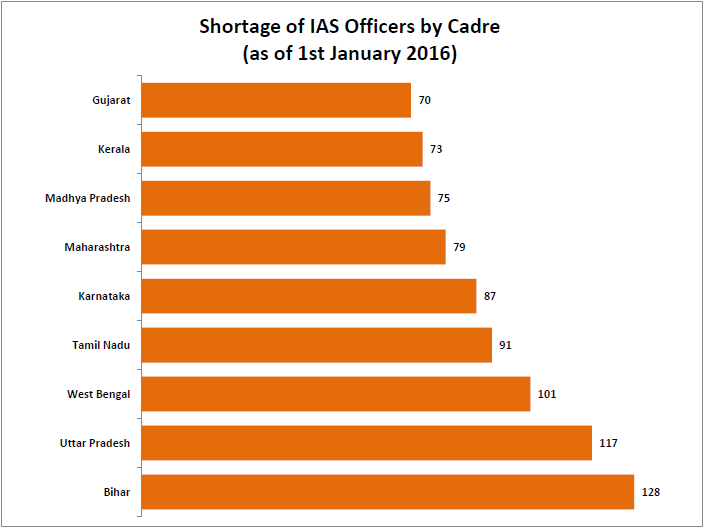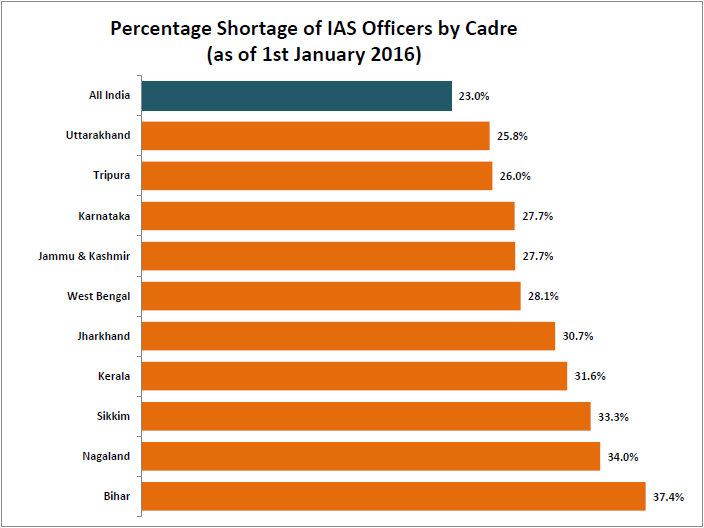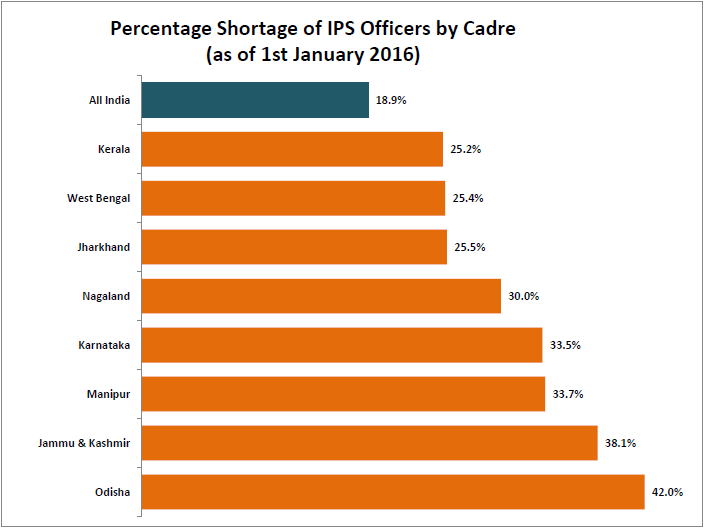[orc]As per the data shared by the government in the Lok Sabha, India faces a 23% shortage of IAS officers and 19% shortage of IPS officers. Bihar faces the highest ( 37.4%) shortage of IAS officers while Odisha faces the highest (42%) shortage of IPS officers.
Both IAS & IPS belong to the elite All India Services (AIS). The IAS officers & IPS officers are allocated to various cadres based on the respective cadre allocation rules. As per the latest data shared by the government in the Lok Sabha, India faces a 23% shortage of IAS officers and 19% shortage of IPS officers as of January, 2016. Some states have been facing an acute shortage of the IAS & IPS officers for a long time now.
Cadre Strength is reviewed regularly
The fixation of the strength and composition of a cadre of AIS officers is governed by the Cadre Rules, separately framed for each AIS. The cadre strength is reviewed ordinarily at the interval of every five years. A State Government can also seek mid-term cadre review to increase the cadre strength. There are currently 26 cadres each for IAS & IPS.
Bihar faces a 37.4% shortage of IAS Officers
As of 1st January 2016, the total authorized strength of IAS officers across the country is 6396. Of this, only 4926 officers are in position and there is a shortage of 1470 officers or 23% of the authorized strength. Uttar Pradesh has the highest authorized strength of 621 IAS officers followed by Madhya Pradesh (417) and Tamil Nadu (376). Eight (8) different cadres have a total authorized strength of more than 300 each. Three cadres (Sikkim, Nagaland & Tripura) have a total authorized strength of less than 100 each.

Bihar faces the largest shortage of IAS officers (128) followed by Uttar Pradesh (117) and West Bengal (101). Twelve (12) different cadres face a shortage of more than 50 IAS officers each. Only four (4) cadres face a shortage of less than 30 IAS officers each. The average shortage of IAS officers per cadre is 57.

Bihar also faces the highest shortage of IAS officers in terms of percentage (37.4%) followed by Nagaland (34%). Five (5) cadres face a shortage of more than 30% each while eight (8)cadres face a shortage of less than 20% each. On the whole, 12 cadres face a shortage which is more than the All India average while 14 other cadres face a shortage which is less than the All India average.
Odisha faces a 42% shortage of IPS Officers
As of 1st January 2016, the total authorized strength of IPS officers across the country is 4802. Of this, only 3894 officers are in position and there is a shortage of 908 officers or 18.9% of the authorized strength. Uttar Pradesh has the highest authorized strength of 517 IPS officers followed by West Bengal (347) and Madhya Pradesh (305). Six (6) different cadres have a total authorized strength of more than 250 each. Six cadres (Sikkim, Nagaland, Tripura, Uttarakhand, Himachal Pradesh & Manipur) have a total authorized strength of less than 100 each.

Uttar Pradesh faces the largest shortage of IPS officers (114) followed by West Bengal (88) and Odisha (79). Eight (8) different cadres face a shortage of more than 50 IPS officers each. Ten (10) cadres face a shortage of less than 30 IPS officers each. The average shortage of IPS officers per cadre is 40. It has to be noted that the cadre allocation of 140 IPS Probationers of the 2015 batch is still pending. The shortage in different cadres might reduce after the allocation.

Odisha faces the highest shortage of IPS officers in terms of percentage (42%) followed by Jammu & Kashmir (38.1%). Five (5) cadres face a shortage of more than 30% each while thirteen (13) cadres face a shortage of less than 20% each.
Featured Image:Image


